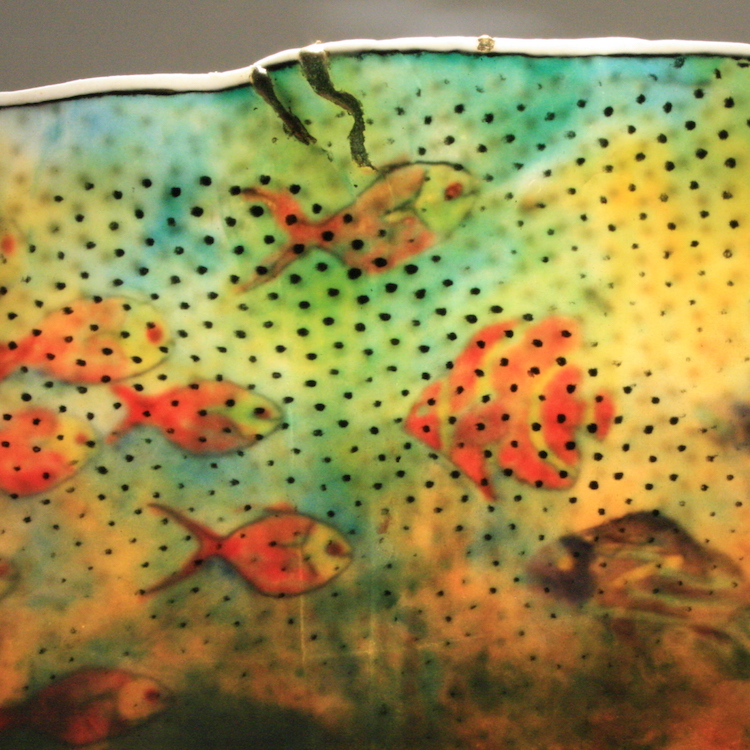COLUMBUS, Ohio — Depicting dreamy and romantic scenes of fish, coral and underwater vegetation, stratified sediment and skeletal forms, the group exhibition between Curtis Benzle, Thomas Hoadley and Jennifer McCurdy, Three Masters in Porcelain (June 4 – July 16, 2017) at Sherrie Gallery features vastly different applications and manifestations of the material.
Featured image: Curtis Benzle, Mundo Durado (detail), Porcelain, 7 x 12 x 3.5 inches

Curtis Benzle, Mundo Durado, Porcelain, 7 x 12 x 3.5 inches. Click for larger image

Curtis Benzle, Alhambra Luz, porcelain, 7 x 16 x 5 inches. Click for larger image

Curtis Benzle, Alhambra Luz (detail), porcelain, 7 x 16 x 5 inches. Click for larger image

Curtis Benzle, Regresar, Porcelain, 7 x 16 x 5 inches. Click for larger image
On Benzle’s artist page, he argues that translucency is an overlooked hallmark of porcelain.
Translucency suggests. Translucency implies. Translucency entices and encourages closer examination.
Clearly transmitted light—transparency–excites the senses. Caressed light—translucency—soothes the senses. My aesthetic intention is to provide a visual sanctuary. Translucency is a vital tool required to realize that intention.

Curtis Benzle, Vieques, Porcelain, 6 x 15 x 5 inches

Curtis Benzle, Ascending Scale, porcelain, 7 x 12 x 3.5 inches. Click for larger image

Curtis Benzle, Autumnal Glow, Porcelain, 54 x 13 x 8 inches. Click for larger image

detail

detail
We agree. Using the traditional Japanese technique of nerikomi, his work evokes a sense of warmth and satisfaction with the lighting showcasing the porcelain’s delicate ripples, layering and sumptuous forms. Colorful glaze becomes illuminated as darker glaze lends itself as a mask to stunning effect. Benzle’s work is like a softer reinterpretation of stained glass.
With the appearance of layered sediment found in Utah’s slot canyons, Thomas Hoadley’s colored porcelain vessels are also made using the nerikomi technique.
[The process] involves the layering of different colored clays, resulting in a penetration of the pattern through the thickness of the wall so as to be visible on both the outside and the inside. By using this technique, pattern and structure become one and the same, translating the amazing plasticity of clay into a visual format.

Thomas Hoadley, Bowl 1107, Colored porcelain, 8.75 x 5.25 x 5 inches
The artist says he was drawn to the technique because of its “organic union of pattern and structure. “
Straight parallel lines are created by stacking up slices of various colored clays but in the manipulation of the resulting soft block of clay, the lines become undulating or are perhaps made to taper down to hair’s breadth. Porcelain, of course, shows off this quality to its greatest extent but the principle is the same with any clay.

Thomas Hoadley, Bowl 1098, colored porcelain, 5.75×4.75×4.75 inches
Jennifer McCurdy‘s work has been focusing on questions of structure, and like Benzle, also strives for translucency.
How thin can she make the high fire porcelain before it collapses in the fire? How much can she cut away and still maintain the structural integrity? How can she preserve the movement of the wheel and the fire in the finished piece?

Jennifer McCurdy, Gilded Fire Vessel, wheel-thrown, altered, and carved porcelain, 17 x 12 x 12 inches
In her artist statement, she says structure found in nature lends itself to emotion.
Emotion fills me when I see perfect forms in nature, from the cracked conch shell on the beach revealing its perfect spiral, to the milkweed pod burst in the field, its brilliant airborne seeds streaming into the sunlight. The ordered symmetry and asymmetry of nature’s forms reveal the growth of life, the movement of life.

Jennifer McCurdy, Coral Nest, wheel-thrown, altered, and carved porcelain, 18 x 13 x 13 inches
About the artists:
Curtis Benzle graduated with a BFA from the Ohio State University in 1972, and received his Masters from Northern Illinois University in 1978. His work is included in many major museums and collections, including the Metropolitan Museum of Art, the Smithsonian, the Los Angeles County Museum of Art, and the White House Collection of Contemporary Crafts. Benzle is Professor Emeritus at the Columbus College of Art and Design, and currently lives and works in Huntsville, AL.
Thomas Hoadley grew up in New Hampshire and graduated from Amherst College in 1971, then attained a Masters in Ceramics at Illinois State University. His work is included in the collections of many public museums including the National Museum of American Art – Renwick Gallery, the Museum of Fine Arts – Boston, the Museum of Fine Arts – Philadelphia, and the White House Craft Collection (now at the Clinton Library). Hoadley is the recipient of a Massachusetts Artists Fellowship, two NEA Grants, and a Bronze Metal at the International Ceramics Festival Mino ’95, Tajimi City, Japan. His work has been exhibited and published both nationally and internationally. He currently resides in Lanesborough, Massachusetts.
Jennifer McCurdy received her Fine Arts degree from Michigan State University in 1978, and has worked as a ceramic artist ever since. Her work resides in the collections of museums around the world, including the Smithsonian Museum’s Renwick Gallery, the Philadelphia Museum of Art and the Everson Museum of Art. She currently lives with her husband on the island of Martha’s Vineyard.
Do you love or loathe this exhibition from the worlds of contemporary ceramic art and contemporary ceramics? Let us know in the comments.
We also liked some of Benzle’s previous cubic works, and we wanted to share some of them with you.

Curtis Benzle, Selva, Porcelain




Add your valued opinion to this post.